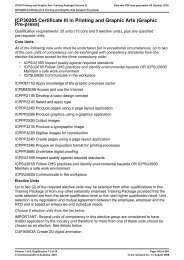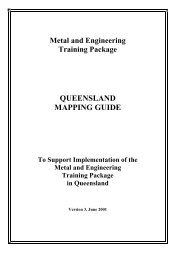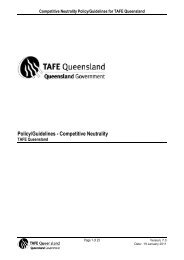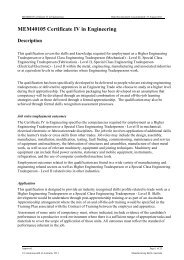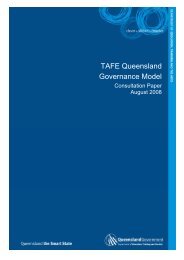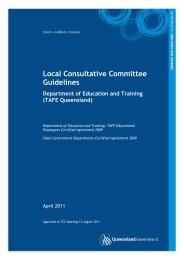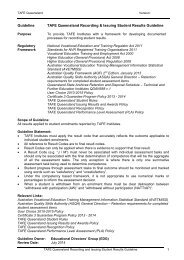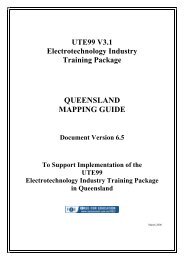The Crux of the Matter - Training Queensland - Queensland ...
The Crux of the Matter - Training Queensland - Queensland ...
The Crux of the Matter - Training Queensland - Queensland ...
You also want an ePaper? Increase the reach of your titles
YUMPU automatically turns print PDFs into web optimized ePapers that Google loves.
Tip 2: Addressing access and equity issues<br />
It is important that you identify <strong>the</strong> demographics <strong>of</strong><br />
your learners – who your clients are, how this might<br />
affect <strong>the</strong> way you communicate with <strong>the</strong>m, and <strong>the</strong><br />
types <strong>of</strong> LLN support <strong>the</strong>y might need in a training<br />
program. Information custom built for particular<br />
audiences has <strong>the</strong> greatest impact, <strong>the</strong>refore<br />
a carefully planned communication strategy<br />
is essential. Some clients will need particular<br />
consideration. <strong>The</strong>se clients may include people:<br />
• whose first language is not English<br />
• who have been educationally disadvantaged,<br />
for example non-completion <strong>of</strong> an equivalent to<br />
compulsory schooling in Australia<br />
• in older age groups<br />
• whose training has been disrupted by disability<br />
• who have had long periods <strong>of</strong> unemployment<br />
• from specific cultural or ethnic groups<br />
• from an oral communication tradition<br />
• who have good English speaking and listening<br />
skills but low reading and writing skills<br />
• who have good skills in a language o<strong>the</strong>r than<br />
English, but who need to use English language in<br />
an Australian context.<br />
You should consider your client pr<strong>of</strong>ile to get<br />
a general indication <strong>of</strong> <strong>the</strong> ways in which you<br />
communicate and <strong>the</strong> types <strong>of</strong> LLN support that<br />
may be needed. Remember that <strong>the</strong>re are no<br />
hard and fast rules about who will need support,<br />
and judgements based on stereotypes should be<br />
avoided.<br />
Communication strategies<br />
Depending on <strong>the</strong> scale and scope <strong>of</strong> operations and<br />
your client base, you could consider <strong>the</strong> following<br />
strategies to help ensure all people have access to<br />
your information:<br />
• You could engage interpreters to communicate<br />
with people from different language backgrounds.<br />
• Carers, associates and o<strong>the</strong>r advocates should<br />
be invited to participate in, and where necessary<br />
communicate information on behalf <strong>of</strong> clients.<br />
• Accessible websites should be provided to help<br />
people with a disability.<br />
• Information provided online, by email or Short<br />
Message Service (SMS) may assist people who are<br />
Deaf or hard <strong>of</strong> hearing.<br />
However, <strong>the</strong>se strategies will only be useful if<br />
potential clients are informed about <strong>the</strong>m and o<strong>the</strong>r<br />
staff know how to use <strong>the</strong>m.<br />
Resources<br />
Resources: Inclusive practices:<br />
text including website text, should<br />
be produced according to Universal<br />
Design Principles to enchance access.<br />
<strong>The</strong> online resource Working with Diversity provides<br />
a range <strong>of</strong> practical strategies for dealing with issues<br />
relating to access and equity.<br />
18 <strong>The</strong> <strong>Crux</strong> <strong>of</strong> <strong>the</strong> <strong>Matter</strong> - Language, Literacy and Numeracy and Vocational Education and <strong>Training</strong>





